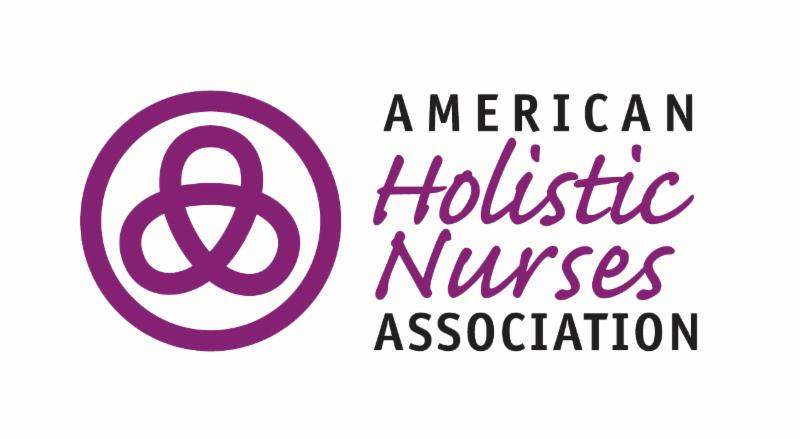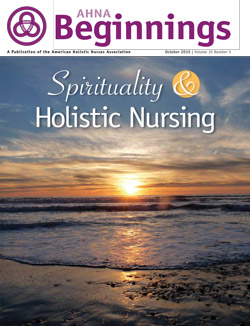| Holistic Nursing Research: Evidence to Support AHNA Holistic Core Values |
Guest Editor Cynthia Barrere

Core values summarize the ideals and principles of a specialty (Mariano, 2016) and are strengthened by research evidence. The purpose of this editorial is to share examples of holistic nursing research that highlight each holistic core value. These examples meaningfully integrate the art and science of the core values, demonstrating how holistic nursing continues to advance based on the evidence, purposefully moving forward to realize the vision of AHNA. Complete citations of the articles summated here are located in the reference section.
Core Value 1: Holistic Philosophy, Theory, and Ethics
Koren & Papamiditriou (2013) provide an example of the application of Modeling and Role Modeling Theory (MRMT) to examine the spiritual needs of staff nurses using a descriptive qualitative approach. They developed the study based on the premise of MRMT that in order for nurses to attend to the spiritual needs of patients, they need to address their own spiritual needs (Erickson, 2006). MRMT includes the concept of self-care which, in turn, brings to the forefront the significance of caring for self and recognizes that "self" includes nurses. MRMT asserts the nurse views the patient's situation from the patient's perception. Audio-recorded focus groups were held in which participants discussed "care of the patient" and "care of self". The method description included the strategies used to enhance the accuracy of the resulting descriptive themes that emerged to increase readers' confidence in the findings. Themes highlight the importance of nurses establishing caring relationships with patients, and that such relationships bring meaning and purpose to their clinical work. Also deemed important are administrative presence, time for reflection on events related to nurses' spirituality, and increased chaplain support.
Core Value 2: Holistic Caring Process
 Osteoarthritis is one of the most common chronic conditions experienced by older patients that leads to pain and disability (Park, McCaffrey, Newman, Cheung, & Hagen, 2014). Park et al. (2014) conducted a quasi-experimental quantitative study with a control group to examine the effects of Sit 'N' Fit Chair Yoga on pain and psychological and physical functioning. The investigators selected chair yoga for this population because many patients with osteoarthritis are not able to ambulate well independently. Chair yoga was felt to be a safe and mild form of exercise. The Sit 'N' Fit chair-based yoga sessions ran twice a week for 8-weeks. Four aspects of regular yoga were incorporated into these 45 minute sessions. Findings indicated greater decrease in depression and improvement in life satisfaction in the yoga group than in the control group. Nurses, social workers, and other health care providers might consider recommending the Sit 'N' Fit Chair Yoga program to older adults with osteoarthritis who are otherwise not able to exercise. Osteoarthritis is one of the most common chronic conditions experienced by older patients that leads to pain and disability (Park, McCaffrey, Newman, Cheung, & Hagen, 2014). Park et al. (2014) conducted a quasi-experimental quantitative study with a control group to examine the effects of Sit 'N' Fit Chair Yoga on pain and psychological and physical functioning. The investigators selected chair yoga for this population because many patients with osteoarthritis are not able to ambulate well independently. Chair yoga was felt to be a safe and mild form of exercise. The Sit 'N' Fit chair-based yoga sessions ran twice a week for 8-weeks. Four aspects of regular yoga were incorporated into these 45 minute sessions. Findings indicated greater decrease in depression and improvement in life satisfaction in the yoga group than in the control group. Nurses, social workers, and other health care providers might consider recommending the Sit 'N' Fit Chair Yoga program to older adults with osteoarthritis who are otherwise not able to exercise.
Core Value 3: Holistic Communication, Therapeutic Healing Environment, and Cultural Diversity
Bicultural straddling is defined as an ongoing process of adaptation resulting from living within two different cultural influences (Kao & Haung, 2015). Kao and Haung (2015), used a qualitative deductive analysis of bicultural straddling to provide nurses with information in caring for culturally diverse second generation adolescents (Elo & Kyngäs, 2008). This method helped in guiding the researchers' understanding about how immigrant adolescents straddle cultural influences between their homes and society. Four attributes of bicultural straddling were revealed: cultural distance between family and society, degree of active engagement in both cultures, ability to balance separate cultural influences, and integration of one's identity. Following descriptions of these attributes, compelling illustrative model cases and contrary cases are shared. This research provides profound evidence to guide nurses caring for, or promoting healthy behaviors for diverse patients.
Core Value 4: Holistic Education and Research
 Chan and Larson (2015) conducted a systematic review to examine the plethora of evidence on meditative interventions used in chronic illness. To focus their research exploration, they defined meditative interventions as sitting meditation in which meditation was the main or only content of the intervention with or without the addition of mindful movement. Forty-five studies that examined the effect of meditative intervention on levels of anxiety, depression, and chronic disease symptoms in persons with chronic disease were identified and evaluated. The systematic review included an evaluation of the research quality and consistency of the application of the meditative intervention in each study. Seven categories of meditative interventions were found, for example mindfulness-based stress reduction (most often used), exclusive meditation, and exclusive medication/movement. Also, most studies tested the intervention over an eight-week period of time. Half of the studies had clearly defined and specific meditative interventions and half were randomized control trials. Findings revealed a lack of consistency regarding types of meditative interventions and their use; further research is needed. However, the review demonstrated consistent positive outcomes of decreased anxiety, depression, and symptoms of chronic disease when the meditation used only exclusive attention. Exclusive attention is a basic level skill that is easy to learn and teach, thus this study provides evidence for potential use of exclusive attention in practice. Chan and Larson (2015) conducted a systematic review to examine the plethora of evidence on meditative interventions used in chronic illness. To focus their research exploration, they defined meditative interventions as sitting meditation in which meditation was the main or only content of the intervention with or without the addition of mindful movement. Forty-five studies that examined the effect of meditative intervention on levels of anxiety, depression, and chronic disease symptoms in persons with chronic disease were identified and evaluated. The systematic review included an evaluation of the research quality and consistency of the application of the meditative intervention in each study. Seven categories of meditative interventions were found, for example mindfulness-based stress reduction (most often used), exclusive meditation, and exclusive medication/movement. Also, most studies tested the intervention over an eight-week period of time. Half of the studies had clearly defined and specific meditative interventions and half were randomized control trials. Findings revealed a lack of consistency regarding types of meditative interventions and their use; further research is needed. However, the review demonstrated consistent positive outcomes of decreased anxiety, depression, and symptoms of chronic disease when the meditation used only exclusive attention. Exclusive attention is a basic level skill that is easy to learn and teach, thus this study provides evidence for potential use of exclusive attention in practice.
Core Value 5: Holistic Nurse-Self-Reflection and Self-Care
Nursing students experience a great deal of stress that leads to negative physical, psychological, and academic outcomes (Wolf, Stidam, & Ross, 2015). Delaney et al. (2015) developed and tested an evidence-based stress-management program with junior nursing students in two universities: NURSE (Nurture nurse, Use resources, foster Resilience, Stress and Environment management) that teaches nursing students to develop stress management plans. An explanatory sequential mixed methods design was used in this pilot study. The program was grounded in Watson's Theory of Human Caring (Watson, 2008) and followed students over a six-month period of time. This innovative teaching approach incorporated high fidelity and standardized patient simulation into the program to provide opportunities for students to practice the skills, thus reinforcing understanding and learning. The quantitative method used was a randomized pilot design that included an examination of students' knowledge of stress management, stress level, and level of resilience before, immediately following the NURSE intervention, and four months later. A non-significant trend toward increased resilience was revealed in the intervention group. The qualitative component used Colaizzi's (1978) phenomenological approach to capture students' lived experience using the NURSE intervention. Seven themes emerged such as: "remembering to hit the pause button" and "finding new ways of doing and being". Overall findings indicate the NURSE intervention is highly feasible and has potential for nursing faculty in improving nurse education by empowering junior students to care for themselves.
An increasing number of wonderful holistic nursing research studies are available that provide evidence for the core values and inspire additional studies to provide ongoing evidence as nurses aim to reach the ideals of holistic nursing. The articles shared here illustrate a small sampling of various research designs and evidence available. Holistic nurses are encouraged to journey through the literature on a topic pertinent to their areas of practice. New information and surprising findings are often discovered that can be helpful in improving holistic practice and patient outcomes.
References
Chan, R. R. & Larson, J. L. (2015). Meditation interventions for chronic disease populations: A
systematic review. Journal of Holistic Nursing, 33(4), 351-365.
Colaizzi, P. R. (1978), Psychological research as the phenomenologist views it. In R.S., Valle, R. S. & King, M. (Eds.), Existential Phenomenological Alternatives for Psychology, (pp. 48-71), New York, NY: Oxford University Press.
Delaney, C., Barrere, C., Robertson, S., Zahourek, R., Diaz, D., & Lachapelle, L. (2015). Pilot testing of the NURSE stress management intervention. Journal of Holistic Nursing, Dec 30. pii: 0898010115622295. [Epub ahead of print] PMID:26721516
Elo, S. & Kyngäs, H. (2008). The qualitative content analysis process. Journal of Advanced Nursing, 62(1), 107-115. Erickson H., (Ed.) (2006). Modeling and Role-Modeling: A View from the Client's World. Cedar Parks, TX: Unicorns Unlimited. Kao, T.-S. A., & Huang, B. (2015). Bicultural straddling among immigrant adolescents: A concept analysis. Journal of Holistic Nursing, 33(3), 269-281. Koren, M. E. & Papamiditriou, C. (2013). Spirituality of staff nurses: Application of modeling and role modeling theory. Holistic Nursing Practice, 27(1), 37-44. Mariano, C. (2016). Holistic nursing: Scope and standards of practice. In, Dossey, B. M. & Keegan, L. (AUs.), Barrere, C. C., Helming, M. A., Shields, D. A., & Avino, K. M. (Eds.) Holistic Nursing: A Handbook for Practice. Jones & Bartlett Learning: Burlington, Mass. Park, J., McCaffrey, R., Newman, D., Cheung, C., and Hagen, D., (2014). The effect of Sit 'N' Fit chair yoga among community-dwelling older adults with osteoarthritis. Holistic Nursing Practice, 28(4), 247-257. Watson, J. (2008). Watson, J. (2008). Nursing: The Philosophy and Science of Caring. Boulder, Colorado: University Press of Colorado. Wolf, L., Stidam, A. W., & Ross, R. (2015). Predictors of stress and coping strategies of US accelerated vs generic baccalaureate nursing students: An embedded mixed methods study. Nurse Education Today, 35(1), 201-205.
Cynthia Barrere, PhD, RN, CNS, AHN-BC is a Professor of Nursing at Quinnipiac University School of Nursing, North Haven, CT.
|
|
Research Profile: Margaret "Marty" Downey, PhD, RN, AHN-BC, CHTP, CNE
|
In this issue we highlight:
Margaret "Marty" Downey, PhD, RN, AHN-BC, CHTP, CNE
Associate Professor Boise State University School of Nursing
Dr. Marty Downey's teaching specialties are critical care nursing, medical-surgical nursing, health assessment, holistic nursing & health practices, stress management, and humor in health. Marty's Bachelor of Science in Nursing degree is from Marycrest College and her MSN is from Idaho State University with a focus on Nursing Education. She received her PhD from University of Idaho in Adult and Organizational Learning. Marty worked in critical care and was nationally certified in critical care nursing for over 20 yrs and now holds Alumnus CCRN status. She is equally proud of her certification as Advanced Holistic Nurse (AHN-BC) for over 16 yrs. Starting Healing Touch classes in 1994, Marty completed her Certified Healing Touch Practitioner (CHTP) in 2013. Dr. Downey is also a Certified Nurse Educator (CNE). As a member of; American Holistic Nurses' Association (AHNA) since 1996 she is now a member of the AHNA Research Committee.
What is your current area of research? It is an honor to share my story and path of Holistic Nursing research. My current area of research is Holistic Nursing, Healing Touch and most recent is a study with Janet Willhaus, PhD, RN, Mark Siemon, PhD, RN, and Abby Lipschultz, undergraduate nursing student RA on the use of holistic therapies for Test Anxiety in nursing students. It is an extension of the pilot study that was conducted and presented last spring at the AHNA 2015 conference with Alia Crandall, BSN, RA, recipient of the Bea Alley Scholarship for Students Award. The study is in its second data collection analysis as I write this. As a Associate Professor, I am also mentoring a group of nurses in a Research Fellowship collaborative initiative with St. Luke's Health Systems Center for Excellence in Research and Boise State University on A Randomized Control Trial of the effects of Healing Touch for newborn male infants circumcision inpatients with Laurie Bourn-Edwards, BS, RNC, NIC, ASPMN-BC, HTPA, Melora Kellis, BSN, RN and Laura Tivis, PhD. It has always been a privilege and honor to mentor a variety of studies and evidence-based-practice projects for this initiative. Studies include Foley, M.K., Anderson, J., Mallea, L., Morrison, K., (2015) Effects of Healing Touch on Postsurgical Adult Outpatients. Journal of Holistic Nursing. Oct. online edition; A Randomized Trial of the Effects of Aromatherapy (AromaTabs™) on Anxiety and Nausea for Breast Cancer Patients Undergoing PORT access in an Outpatient Setting with Heather Roberts, RN, BSN; EBP projects such as An Evidence Review of the effectiveness of IV Acetaminophine with Marcia Watt, BSN, RN and Kim Krutz, MSN, RN, OCNS-C, CMSRN, and Research Assistant, Nicole Benskin, BSN student (now RN), and recently an EBP project mentoring Debbie Larson, MSN, RN on Simulation and Deliberate Practice in Emergency Response Training: An Evidence Based Practice Project. This project was completed and is being presented on a poster for the St. Luke's Research Fellowship next month. Tell us how you got started in research and how it evolved over the years. I remember when I was in the midst of my doctoral program and the Chair of the nursing program, Dr. Pamela Springer, said that my Ph.D. would allow me to do more research and I thought "that is not my goal, I love teaching" however, that has evolved a bit over the years. My introduction to research began in my undergraduate nursing education in the BSN program with a pilot study on the effects of Pre-operative patient education. My MSN thesis focused on Effects Of Placement Of Theory And Clinical On Acquisition Of Basic Critical Care Knowledge In Undergraduate Nursing Students set the stage for further research. The next foray in research was on the Effects of Holistic Nursing course: a paradigm shift for health presented at the 2006 AHNA conference and published in the JHN (2007) and another study on the use of journaling for nursing students with Susan Parslow, PhD, RN and undergraduate student, Carolyn Punt (now BSN, RN, AGNPc) presented at AHNA 2009. In my doctoral program, my 2006 dissertation research focused on the education and use of complementary therapies such as massage, imagery, Therapeutic or Healing Touch, acupuncture, aromatherapy and other modalities by Idaho nurses in personal and professional practice. The results of the study indicate that the nurses who responded to the survey and interviews utilize complementary therapies into their health promotion practices however those nurses who were educated in nursing programs longer than 10-12 years before the time of this study did not have formal education in these therapies and most often are hesitant to use them for professional practice in spite of the upsurge of complementary medical practice used by consumers. I have promoted research in Healing Touch and other related therapies as a fellowship mentor for three research teams at St Luke's Health System, Boise, ID. Attending the American Holistic Nurses' convention (AHNA) 2012 with three other Boise State U School of Nursing students & St Luke's Wood River Research Fellowship team and the Healing Touch International 2012 Conference to highlight the Holistic Nursing course & Healing Touch effects on postsurgical adult outpatients. In 2014 and 2015 I collaborated for subsequent presentations at the AHNA conferences including other poster presentations on related holistic research. Additionally, I collaborated with Dr. Susan Parslow and Dr. Marcia Smart on The Hidden Treasure in Nursing Leadership: Informal Leaders published in the Journal of Nursing Management 2011. As noted above, along with the Test Anxiety study on nursing students with the interventions of Aromatherapy, my more recent studies are listed above and include my role as research mentor with the St. Luke's Research Fellowship Laurie Bourn-Edwards, BSN, RN, on the effects of Healing Touch on infant males receiving circumcision. This study will close in February followed by analysis of data and report of results. The PhD and research role has also allowed me to be a member of graduate student master's projects and studies as well as consultant on other research studies such as Dr. Christina Sieloff's qualitative study on a revision of a Nursing Work Team Empowerment Instrument.
What are some of your biggest challenges, surprises, and joys in doing research?
Some of the biggest challenges that I encounter with research is the time and the resources to plan, implement, and write up all of the pieces and parts of the study. The faculty workload often creates a void in time allotted to focus on these research projects. Working with nursing students who are Research Assistants and faculty, plus collaborating and mentoring nurses and other healthcare providers in research and evidence-based practice projects has been positively joyous. Additionally, publications, presenting the results of the research at the AHNA conferences with the nursing students and nurses from the Research Fellowship has been an even greater blessing.
What excites you about the future of Holistic Nursing Research? The most exciting thing about research for me is implementing the intervention and data collection as well as getting the results from the analysis then sharing the research study information with others in posters or presentations and, as noted, publication is always a thrill. This is what I envision for the future of Holistic Nursing Research...motivating and stimulating more undergraduate and graduate nursing students to promote safe, quality, effective holistic healthcare throughout the global community. As a member of the AHNA Research committee, I feel privileged to work with some of the most influential leaders and researchers in this field of Holistic Nursing. It is a continual process and one that I will continue to champion in my soon to be role of Emeritus Faculty at Boise State University beginning in May 2016.
Thank you for this opportunity to share my story and may you all benefit from the outpouring of holistic nursing research in our future.
|
|
Student Corner
|
Emotional Intelligence and Soft Nursing Skills:
Student Perspectives of a Nursing Course with Service-Learning
by Cheryl A. Passel
My research focused on the soft skills encompassing the art of nursing. The art of nursing, often referred to as aesthetic knowledge, is comprised of the qualities of caring, empathy, and compassion (Lafferty, 1997). The art and science in nursing are essential components to the delivery of holistic and individualized patient care
The participants for this mixed-method study, were students enrolled in a nursing course with a service-learning component. Participants completed an Emotional-Social Competence Inventory (ESCI) and they submitted reflective journals from their service-learning experiences. The aim of the study focused on soft skills, specifically, self-awareness and empathy
Cheryl Passel is a board certified advanced holistic nurse, assistant professor, and RYT 200 yoga instructor. She teaches psychosocial theory and clinical at Marian University in Fon Du Lac WI and often presents topics related to stress and coping and mind body fitness to students and faculty in academic and community settings. Her dissertation focused on service-learning as a teaching strategy to enhance soft skills, specifically, self-awareness and empathy.
Masters and Doctoral students are invited and encouraged to send abstracts of their thesis/dissertations/ quality improvement projects and submit to Connections in Holistic Nursing Research for possible publication in the Student Corner. This gives students an opportunity to publish and allow others to gain interest in their work. If you are a mentor or advisor for a graduate student, please encourage them to share with us. Please send your submissions to Dr. Michalene A. King at kingm@rmu.edu or michalene1@comcast.net We look forward to reading about your scholarly work.
|
Research Term: Data Collection in Nursing Research
|
Pamela Crary, PhD, RN, AHN-BC
 Common data collection and measurement methods used in nursing research include physiological measures, observation, interviews, questionnaires, and scales. Common data collection and measurement methods used in nursing research include physiological measures, observation, interviews, questionnaires, and scales.
Observational measurement involves an interaction between the subjects and the observer(s), where the observer has the opportunity to watch the subject in a specific setting. Unstructured observations involve spontaneously observing and recording what is seen in words. Structured observations are carefully defined, with specific guidelines about how the observations are to be made, recorded, and coded.
An interview involves verbal communication between the researcher and the subject. There are a variety of approaches, ranging from unstructured interviews, in which the content is completely controlled by the subject, to structured interviews with carefully designed responses.
A questionnaire, or survey, is a self-report form designed to elicit information through written, verbal, or electronic responses. They are distributed and administered in a variety of ways. The information obtained from questionnaires is similar to that obtained by an interview, but the questions tend to have less depth; however, questions are presented in a consistent manner and the opportunity for bias is less.
A scale is a more precise means of measuring than a questionnaire. Most scales measure psychosocial variables; there are some used with physiological variables, such as pain or nausea. Items on summated scales are summed to obtain a single score.
Commonly used scales include rating scales, Likert scales, and visual analog scales.
A rating scale lists an ordered series of categories of a variable that are assumed to be based on an underlying continuum. A numerical value is assigned to each category, and the fineness of the distinctions between categories varies with the scale.
Likert scales, the most commonly used of scaling techniques, are designed to determine the opinions or attitudes of study subjects. This scale contains a number of declarative statements with a scale after each statement. Response choices in a Likert scale most commonly address agreement, evaluation, or frequency.
The visual analog scale (VAS) is typically used to measure strength, magnitude, or intensity of individuals' subjective feelings, sensations, or attitudes about symptoms or situations.
|
|
Nominations Wanted for AHNA Research Chair
Deadline is February 16, 2016 |
 Are you ready to take a more active role in AHNA? Are you ready to take a more active role in AHNA?
Call for nominations for Research Chair 2016-2018. Self-nominations are welcome.
Research Chair
- The Research Chair oversees all research activities for the AHNA.
- The Research Chair shall be a registered nurse with a graduate nursing degree(s). Expertise and experience as a nurse researcher are required. Member of AHNA Research Committee for a minimum of 1 year.
- Research Chair Activities:
- Collaborates with Board of Directors Research liaison and Members in defining goals and objectives for the association and in particular, identifying direction for research activities.
- Implements the three (3) primary goals for AHNA research:
- Foster the development of research in AHNA.
- Supports AHNA members' research activity by developing research-related activities and oversight of/participation in current programs, such as research grants, consultation, and mentorship programs.
- Dissemination and communication of AHNA membership research activities to the membership and healthcare community.
- Coordinates activities of the research committee such as research e-newsletter, webinar, journal club. etc.
- Recommends research representative for the AHNA Conference Planning Committee, and participates in conference-related activities (i.e., abstract reviews).
- Oversees Vice-Chairs and subcommittees or other task forces as well as research-related work assigned by the President or Board of Directors.
Research Vice-Chair
- The Research Vice-Chair coordinates research development activities of the Research Committee.
- The Research Vice-Chair shall be a registered nurse with a graduate nursing degree and doctoral degree. Active membership on the AHNA Research Committee for a minimum of one (1) year and expertise and experience as a nurse researcher are required.
- Vice-Chair activities:
- Collaborates with the Research Committee Chair and the Vice-Chair for Dissemination to identify Research Committee goals and strategies for achieving and evaluating goals.
- Assists in developing and overseeing activities to develop knowledge and skills of holistic researchers, such as mentoring new researchers and research webinars, and evidence for practice.
- Coordinates the Research Consultation/QI program and Research Consultations at the annual conference. Promotes and advertizes programs.
- Collaborates with the Research Committee Chair to identify the Research Committee representative to the AHNA Special Awards Committee.
- Coordinates research webinars and Journal Club.
|
|
A Call to Action for Research
| |
 In our April 2015 research e-newsletter, we launched a new feature, "A Call to Action for Research." The inaugural presentation by Wendy Stivers discussed the ghettoization of health care. In our April 2015 research e-newsletter, we launched a new feature, "A Call to Action for Research." The inaugural presentation by Wendy Stivers discussed the ghettoization of health care.
Do you have a topic that you believe needs to be researched? Would you like to discover that other holistic nurses are also interested in your topic and would like to collaborate? Submit your ideas to Michalene King at kingm@rmu.edu or michalene1@comcast.net for possible inclusion in a future e-newsletter.
Michalene King
|
| AHNA Researchers in Action |
Publications
Christina Jackson. (November/December 2015). Health As Justice. Holistic Nursing Practice, 29(6), 396-397.
AHNA members names in bold. We would love to hear about your research. Have you started your dissertation, had a paper published, presented, etc. Send your "Researcher in Action" to research@ahna.org. For publications, click on the article title for link to abstract (if available).
|
|
Stay Tuned: Relatedness Matters
|
"Relatedness Matters", an article authored by Pamela Crary, PhD, RN, AHN-BC will be published in Holistic Nursing Practice, Fall 2016.
Abstract:
Today, nurses are confronted with much more in their day-to-day activities than 40 years ago. Not only are nurses caring for more patients during their shifts, patients are acute and complex and have shorter hospital stays. The nurse-patient relationship has been a focus of nursing since the profession began. Nurses today engage with vulnerable individuals in intimate and highly technical environments. Not only do nurses care for people using highly technical skills, but also nurses educate and support individuals toward healing by listening, and encouraging people toward improved health. The relationship between nurse and patient remains relevant today and important for patient outcomes. This publication introduces a theoretical approach that exemplifies the importance of relatedness in maintaining the nurse-patient relationship.
Pamela is an Associate Professor of Nursing at Edgewood College, Madison WI and also a Nurse Scientist at the Wm. S. Middleton Memorial Veteran's Hospital in Madison, WI.
|
|
Call for 2016 Beginnings Articles
|

AHNA is requesting articles for Beginnings magazine on Advanced Practice Holistic Nursing/ The Holistic APRN. The submission deadline is March 15th.
|
| AHNA 2016 Charlotte, NC Regional Conference |

Join AHNA at our third regional conference entitled Holistic Self-Care: Your Secret Power for Enhancing Patient Care at the Beatties Ford Road Library Conference Room B 2412 Beatties Ford Road in Charlotte, NC Friday, March 18, 2016 from 9:30 AM-4:30 PM. The conference Keynote will be Lourdes Lorenz, DHA-abd, MSN-IH, RN, AHN-BC, NEA-BC. The $75 registration fee includes continental breakfast and lunch, as well as 6 continuing education hours. (Registration after Friday, March 11th is $90) To register, visit: www.ahna.org/cne
Need to stay overnight? Call 1-800-HILTONS, use group code "AHN" for a discount rate of $129 at DoubleTree Hilton, 895 W Trade St, Charlotte, NC
|
| Learning With AHNA |
Webinars:
Wednesday, February 17, 2016 at 1:00 pm EST (NOON CST, 11:00 am MST and 10:00 am PST)
Integrating Aromatherapy, It All Began with Florence
Presenter: Mary Natschke, RN, BAS, HNB-BC, IAC
 This program will provide a historical overview that aligns the work of Florence Nightingale, a user of perfumes and smudge pots to provide holistic care to current day integration of aromatherapy into nursing care practice. The presentation will describe two varying models of holistic practice that have successfully added aromatherapy nursing practice to their scope of nursing care delivery. These models will provide strategies, operational design, budget considerations, educational and regulatory challenges. They will also provide the value of evidence based practice, data collection, nursing competency, alignment with institutional goals, and exploring opportunities for success. Register for the 1.0 hour CNE for only $8 for members or sign up for the "Just Listening" webinar for free. This program will provide a historical overview that aligns the work of Florence Nightingale, a user of perfumes and smudge pots to provide holistic care to current day integration of aromatherapy into nursing care practice. The presentation will describe two varying models of holistic practice that have successfully added aromatherapy nursing practice to their scope of nursing care delivery. These models will provide strategies, operational design, budget considerations, educational and regulatory challenges. They will also provide the value of evidence based practice, data collection, nursing competency, alignment with institutional goals, and exploring opportunities for success. Register for the 1.0 hour CNE for only $8 for members or sign up for the "Just Listening" webinar for free.
Wednesday, March 16, 2016 at 1:00 pm EST (NOON CST, 11:00 am MST and 10:00 am PST)
From Chaos to Caritas: Using Caring Science Theory to Change Yourself and Your Department

Presenter: Justin Carpenter, MSN, RN, AGCNS-BC, HN-BC
The purpose of this activity is to enable the learner to identify ways to create a more peaceful environment within themselves and in their department, as well as make more meaningful connections with patients and co-workers. You will soon be able to register for the 1.0 hour CNE for only $8 for members or sign up for the "Just Listening" webinar for free.
|
|
Promoting Research and Quality Improvement in Holistic Nursing through
Consultation Service
| |
AHNA Research Consultation Service
 The AHNA Research Committee is now offering a program for those nurses who want to conduct research or are working on a quality improvement project, but need some guidance. If you are a new researcher who would like some assistance, the AHNA Research Consultation Program is for you. The AHNA Research Committee is now offering a program for those nurses who want to conduct research or are working on a quality improvement project, but need some guidance. If you are a new researcher who would like some assistance, the AHNA Research Consultation Program is for you.
For AHNA members, this service is provided for $20 for one research consultation and $50 for three, and can be purchased online at www.ahna.org/shop. Consultations are expected to be less than one hour, and will be most productive when the Consultation Request Form is thoughtfully completed. For example, providing your area of research interest and other descriptors will enable the program manager to better match you with a consultant. After purchasing your consultation service, you will receive an email receipt that guides you in the process for your consultation. This program is managed by Cindy Barrere, who can be contacted at cynthia.barrere@quinnipiac.edu.
The AHNA Research Committee is very excited to make this service available to the members, continuing their focus to promote and support future researchers in holistic nursing.
|
|